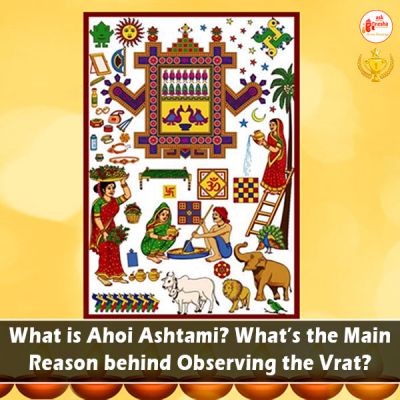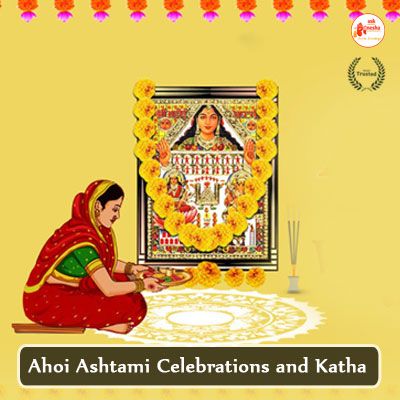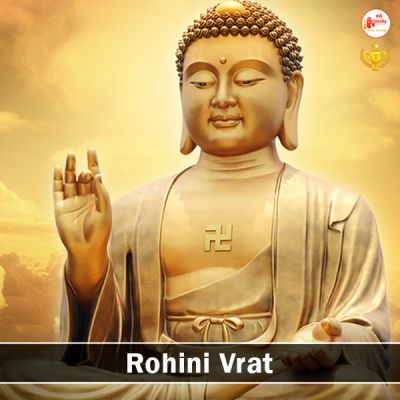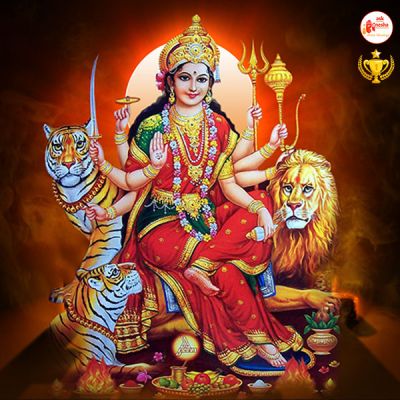Ahoi Ashtami, also known as Ahoi Aathe is a Hindu festival celebrated by mothers for the well-being and longevity of their children. It is observed on the eighth day of the Hindu month of Kartik, usually falling in October or November.
On Ahoi Ashtami, mothers go on fasting from sunrise to shining of the moon in the horizon for the welfare of their sons and daughters. They pray to Ahoi Mata, an incarnate of Goddess Durga or Parvati, who is believed to protect and bless children. The word "Ahoi" is derived from "Aho" that means fast and "Ashtami" is the eighth day, indicating the fasting observed on this particular day.
During the fast, mothers abstain from taking food and water until they see the moon. They break their fast after seeing the moon and offer prayers to Ahoi Mata. Traditionally, a picture or painting of Ahoi Mata is drawn on a wall. A special Ahoi Ashtami Vrat book is read. The mother performs aarti and offers bhog (sacred food) to the deity. This festival has significance mainly in North India, in the states of Uttar Pradesh, Rajasthan, Haryana, Punjab, and Delhi. It is observed with great devotion with the belief that Mother will keep vigil of the well-being and prosperity of their children.
What is its Significance?
Ahoi Ashtami holds great significance for mothers and their kids. The festival is observed with the belief that by fasting and performing the necessary rituals, mothers can ensure the well-being, longevity, and prosperity of their sons and daughters. The word "Ahoi" means fasting, indicating the specific fasting observed by mothers on this very day. Mothers look upon Ahoi Mata, a form of Goddess Durga or Parvati, as the protector of their children. By worshiping her and observing the fast, mothers seek her blessings and protection for the welfare of their kids. It is believed that Ahoi Mata grants the desires and fulfills the wishes of the mothers who observe the fast sincerely.
The fast is broken only after seeing the moon, which marks the end of the day. This act seems to be the completion of the mother's devotion and the fulfillment of her heartfelt prayers. After breaking the fast, the mothers cook special food items and share as prasad among family members. Ahoi Ashtami is such a festival that reinforces the bond between mother and child and celebrates the loving care that mothers have for their children. It is a time for mothers to express their deep affection for their kids and pray for the happiness and well-being of them. Actually, the significance of Ahoi Ashtami lies in its focus on maternal love, protection, and the desire for the prosperity and longevity of respective children.
What is The Vrat Katha?
The Vrat Katha or the legend associated with the occasion is an important part of the festival. It is a narrative that is either recited or read by mothers while observing the day’s fast. The Vrat Katha narrates the origin and significance of the occasion and provides moral and spiritual lessons.
The specific Vrat Katha for Ahoi Ashtami centers round the story of a devoted and caring mother. The details of the story may vary slightly in different regions, but the central theme remains the same. Here we are going to highlight the story associated with the Vrat Katha. Once upon a time there lived a woman with her husband and seven sons in a village. As the wall of the mud hut in which they lived collapsed, the woman went to the forest to collect soil to repair the walls of her house. When she was digging soil, her axe accidentally killed a lion cub. The mother was extremely sorry and remorseful and decided to pray to Ahoi Mata to forgive her for her misdeed.
Years rolled on. The woman's sons faced hardships and were inflicted with illnesses. The mother consulted a wise old woman of the neighborhood who was some kind of a soothsayer too, revealed that their misfortunes were an outcome of the mother's unintentional deed of killing the lion cub. The wise woman advised the mother to go for a strict fast on Ahoi Ashtami to redeem herself from her past unwanted misdeed. She should pray for forgiveness and blessings from Ahoi Mata.
Paying heed to the advice, the mother observed the fast with utmost devotion and sincerity. She prayed to Ahoi Mata and prayed forgiveness for her unintentional mistake. Ahoi Mata, having compassion and mercy, granted her prayer and showered blessings upon her and her children.
The Vrat Katha emphasizes the significance of maternal love, the power of sincere prayers, and the compassion of the divine mother. It highlights the belief that by observing the fast and seeking forgiveness, a mother can protect and ensure the well-being of her children. The Vrat Katha serves as a reminder of the devotion, care, and responsibility that mothers have towards their children. It reinforces the bond between mother and child and inspires mothers to perform their duties with love and sincerity.
All About The Rituals
The rituals of Ahoi Ashtami are performed by mothers who observe the fast for the well-being of their children. Here are the common rituals observed during the festival. Mothers observe a strict fast from sunrise to moonrise on Ahoi Ashtami. They abstain from consuming food and water during this period. The fast is broken only after seeing the moon, indicating the completion of the fast and the fulfillment of their prayers. Before starting the fast, mothers clean and decorate the Puja room or a designated area of their home. They place a picture or painting of Ahoi Mata on a wall or use a special Ahoi Ashtami vrat book for the rituals.
Throughout the day, mothers perform Puja and offer prayers to Ahoi Mata. They light incense sticks, offer flowers, and chant hymns or mantras dedicated to Maa. Aarti is also performed while singing devotional songs. Mothers recite or read the Vrat Katha (fasting story) associated with Ahoi Ashtami. The story narrates the origin and significance of the festival and provides moral and spiritual lessons. After sighting the moon, mothers break their fast by consuming water and some special food items prepared for the occasion. The food items may include puris, halwa, fruits, and other traditional dishes. The food is considered blessed and is shared among family members.
Mothers offer prasad to Ahoi Mata by placing it in front of the picture or idol. The prasad is believed to carry the blessings of the deity. It is then distributed among family members and shared with neighbors and relatives. Ahoi Ashtami is a time for family gatherings and celebrations. Family members come together to participate in the rituals, share the festive meal, and seek blessings from the mother. It is also common to exchange gifts and sweets during this time.
These are the general rituals observed during the very Ahoi Ashtami. However, specific customs and practices may vary among different regions, traditions and families. The underlying essence of the very rituals is to express maternal love, seek blessings for children and reinforce the importance of family unity.
Astrology and Ahoi Ashtami
In astrology Ahoi Ashtami has a great place. Mothers go for the Vrat to go for the great Hindu Vrat dedicated to Mother Durga with the keen desire that their kids remain happy ever after and enjoy good health. Actually the Ashtami brings in Hindu families the glow of family love and bonding. The fast that the mothers go for can bring prosperity and happiness in the family. This is the ideal time to express love for the kids. As per astrology if one goes for the Puja and fast with utmost devotion, it can invoke positive vibes in the lives of children. Ahoi Ashtami is the time when there is turmoil in the cosmos and a metaphysical change in the life all is noticed particularly among the mothers who go for the fast in this holy occasion.
During this time one planet transits to another place and such things happen as per the mysterious power of the holy Mother. Even astrology can believe it too that it is the time when the cosmos is ready to bless the children so that they can enjoy good life and vibrant energy. It is believed too that the transcended power makes a shield round the kids and save them from all kinds of imminent dangers and mishaps. As mothers pray to Ahoi Mother and go for fast their appeal reach the Mother. The Goddess in return blesses them with utmost happiness with their kids. To have defensive shield from the Mother the mothers of this world go on praying so long the prayers reach the Devi Maa.
The pictures drawn on the wall by the mothers and the Puja done with utmost devotion is the main thing that the Mother aspires for. She too being pleased with mothers living on this earth offer them the power with which they can upkeep their kids quite confidently.






















 Translate
Translate